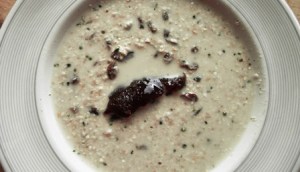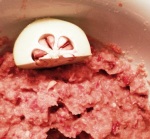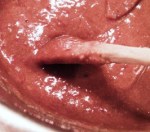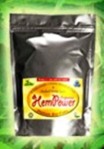
Above pic represents synchronicity and sustainability – and a comforting, tasty and easy-peasy way to get top nutrition. Just add water…
I also dolloped on membrillo – recipe below. It’s nice with something a bit sweet such as sultanas.
Synchronicity: I went to Shambala and got so turned on by hemp porridge, it became the subject of my last post.
Two weeks later, I am at The Organic Food Festival – the after-festival party to be precise at Berwick Lodge, Christopher Wicks’ new fab place – when I find myself talking to what turns out to be:
Rebekah Shaman, founder and director of Amaru Hemp.
Oooooh, I like Rebekah. Right from the start, she plunges me into different worlds with her words for instance about her time as The Shaman’s Last Apprentice in the Amazon.
She also gives me the lowdown on the nutritional powers of hemp:
- 19% protein (meat is 30%)
- easily absorbed globular protein (must find out what globular means)
- every known omega, with omega 3 and 6 ideally balanced
- every known amino acid
- every known essential fatty acid.
One conversation leads to another and soon we realise we were linked in a myriad of different ways, culturally, socially etc.
I am taking this seriously (in an excited way): Amaru organic Hempower and me may have some work to do together in the future. Watch this space.
As for The Organic Food Festival 2009 – wow. Hot brilliant sunshine, old friends, new friends, people trading in a wholesome, future-proof, sustainable ventures – no wonder the atmosphere was elated and connections were buzzing.
I was on The Source stall with my darling editor, Dr Rachel Fleming. We shared it with the renewable energy specialists, Kaieteur, and organic soap makers, Flo and Us, both from Sidmouth.
Also sharing our marquee was James Bond (yes, that is his name) of the Avon Organic Group – his organic damsons were a talking/ tasting point for the crowds.

James gave me some beautiful quince, and this week I made membrillo for the first time, with a recipe from the Avon Organic Group. Here it is (+ my comments).
1. Quarter quince, leaving core, skin, pips intact. Add just enough water for quince to float. Simmer 1 hour or more, or until it reduces to a smooth pulp.
2. Sieve to remove pips and skin.
I am afraid I got fed up of unsatisfactory sieving (and it was midnight when I started). So I blended the whole lot, skin, pips and all. As a result it did not have that pale pink translucency of traditional membrillo – but it packed more of a nutritional punch and tasted richer and denser. (And was less fiddly).

3. Add sugar to equal weight of sieved pulp, or at least 3/4 of weight.
Not being a sugar-freak, I used 1lb 6oz rapadura sugar to 1lb 12oz of fruit. Apologies for imperial measures – this often happens when I cook.
4. Simmer for 1-2 hours or until it has reduced to a thick pulp and darkened considerably. Stir to avoid sticking.
I stirred non-stop for 1 hour, getting spattered with boiling jam when I stopped. Wear an apron!

5. Pour into greased or non-stick baking pan to a depth of 1-1.5 inches.
6. Bake in a low oven (140c) for about 1 hour.
7. It should set to a firm paste. Cool and cut into bite-sized squares.
Mine set to a kind of thick jam.
And it goes really well with hemp porridge.
Stop press: Amaru co-director Carlo Dawson agrees to take Brixton Transition Town pound.


![Reblog this post [with Zemanta]](https://i0.wp.com/img.zemanta.com/reblog_b.png)

Hemp porridge is not only tasty but real healthy. Hemp is rich in iron and vitamin E as well as omega-3 and GLA. What a great way to eat healthy food, adding hemp protein to your porridge.
LikeLike
I’m a little wary of hemp, though I do use it on occasion (especially in my fail-your-drug-test cookies!) While I do think its omega 6 / omega 3 ratio is decent (3:1), I think it’s also important to note that it does not provide DHA or EPA which is what makes the omega 3s in cold water fish so healthy. Moreover, the human body is notoriously inefficient at making DHA and EPA through plant-based sources of omega 3s.
I LOVE membrillo, by the way. That stuff is awesome!
LikeLike
Thank you, Hemp-Oil-Taylor, for finding this post and leaving a comment with a link to the Nutiva hemp website. Glad you liked the sound of hemp porridge!
I have just read the Nutiva story http://bit.ly/in7pI.
Especially fascinated that Nutiva founder wrote America’s seminal bestselling book on composting. Compost fan, me. This method of fertilising the soil (along with rotations and green manures) is far more sustainable than intensive farming’s petrochemicals. Common sense!
Thank you, Jenny, for your informed comment on hemp’s nutritional profile. I did not know that fish omega-3 is more nutritious than plant omega-3. I would love to find out more. Thanks for flagging it up!
LikeLike
Hi Elisabeth
I was at the Organic Food Festival again this year (also haven’t blogged about it yet), but didn’t see you at the Source stall. I was going to say a qucik hello from one blogger to another.
Was another great year wasn’t it? Great weather, amazing food.
On your organic food study post, I totally agree, it is so infuriating. But at the same time I don’t care what the findings are, I eat organic food not because someone tells me to but because I believe it is right.
Claire at Food4two
LikeLike
Hi Claire, thanks for coming to The Source stall. I am sorry I missed you! What time approx did you come? Maybe I was scooting round the festival at the time.
I like what you said about eating organic food because you believe it is right, not because someone tells you so.
Me too. My body prefers its taste and my mind agrees. After eight years at the Soil Association, I know too much about the negative effects of chemical farming and the benefits of organic farming. I am making an informed choice.
What annoys me about the Food Standards Agency’s flawed report is it could stop people making an informed choice.
LikeLike
I read this quote recently and it seems apt, re the FSA.
“Forget the facts. Just give the me the truth.”
Groucho Marx
LikeLike
Jenny there’s nothing to be wary of eating hemp!! I see you have fallen into the usual misconception that hemp is marijuana. Hemp is only from the same family of Cannabis Sativa L. It has only 0.03% THC.
Most of the oily fish is heavily contaminated with mercury and other pollutants, especially cod liver oil – as the liver is where the fish processes the toxins.
Hemp is a fantastic alternative. Hemp seed is the most complete and balanced single source of nutrition available and contains all 20 known amino acids, including the nine essential amino acids that our bodies cannot produce. Approximately 65% of the protein in hemp seeds is made up of the protein Edestin, which is unique to hemp seed and is easily absorbed and utilised by the whole body, and like other globular proteins helps support a healthy immune system.
Essential fatty acids or EFAs found in hemp seed include a balanced 3:1 ratio of Omega 6 to Omega 3 essential fatty acids, and smaller amounts of three other polyunsaturated fatty acids – a unique combination among edible oil seeds.
Hemp seed also provides an adequate supply of antioxidants and trace minerals including calcium, magnesium, sulfur, potassium, phosphorus, iron and zinc.
When you eat hemp you are supporting the growing of hemp which is a wonderful environmental crop and can rejuvenate soil and absorb huge amounts of CO2.
LikeLike
Hi Rebekah, Amaru Hempower organic hemp porridge founder! Thanks for adding the info.
I believe it takes less hemp to give nutrition compared to lots of fish so hemp is the more sustainable option.
And yup: legal hemp is suffering from being mixed up with illegal marijuana – same family but different plant.
This thesis defines the differences, separating myth from reality.
http://bit.ly/1cO9bJ
LikeLike
Pingback: Coed Hills magic and more hemp « Real Food Lover
Pingback: Acetyl-L-Carnitine: The Best Anti-Aging Brain Nutrient that Boosts Your Memory Power | Best Anti Aging Treatments
Hi Elisabeth,
Just wanted to point out that shelled hemp seed is actually 30% (!) protein, HemPower is 19% protein, but the carb/protein balance and the fibre in HemPower (as well as all the essential fats) makes for a more complete meal overall.
The seed is also 47% fat – but just 5% saturated and 0% transfat – the rest is gorgeous essential fats all laid out lovely just as the body likes them!
Peace love and blessings.
Carlo
LikeLike
Ah, thanks Carlo.
Really great to have this clearly explained.
Makes me hungry for a bowl of HemPower.
Which makes me think: How is the blog ad doing? Are the peeps clicking through to the best nutritional instant organic comforting breakfast/ snack on the planet?
LikeLike
Hi just wanted to raise a point, not really linked to hemp porridge but to healthy eating in general. I was looking at a book about the Nordic diet, it says that its comparable in terms of nutrition and healthiness to the well-known sun-ripened Mediterranean diet. The University of Copenhagen, sponsored by the Danish Government, has been researching a balanced diet that will both keep people healthy and at a normal weight, and their findings suggest that the traditional diet, lifestyle and foods produced in northern climates are not only extremely healthy but also environmentally friendly. The Nordic diet is all about eating locally sourced seasonal ingredients combined in a balanced diet of protein, carbohydrate and fat. The traditional diet of Northern Europe with its emphasis on good, home-made and often home-grown, seasonal food consists of a wide variety of grains, berries, vegetables, fish, poultry and game (but very little meat). And the Scandinavian lifestyle is also a great way to keep the body in optimum health: northern Europeans tend to live an outdoor life, maintaining a connection with nature, walking and swimming, with cycling their preferred means of transportation in cities and the countryside. Most importantly, they still eat meals together, around a table, where the senses are nurtured and fulfilled by delicious food and friendly conversation.
Well I have a sneaky suspicion that most traditional diets are super healthy and the down fall of all of them seems to be introduction of sugar and food processing? so i thought why do we have food processing and the answer i came up with was ‘convenience’. So should we continue on this road of convenience? or go back or is there another way? as how can we eat the traditional foods and still life a modern lifestyle? anyway i think i have too much spare time on my hands to be thinking about this stuff, but there we go, be interested to know what you think…
Pete
LikeLike
Hi Pete. Thinking is good! I like thinking. It is one of my favourite activities.
So why does the Western junk-food diet dominate even though it is causing food-related illnesses?
This is an excellent question – it deserves thought! Part of the problem is that people “swallow” (‘scuse pun) what’s on offer – the brightly-packaged food on supermarket shelves – without too much thought.
So thinking is crucial!
Eating a traditional diet in a Western society is much harder to achieve. As you say, it is less convenient. It requires effort to search out small local shops – unlike supermarkets, they don’t have the marketing zillions or the geographical spread.
This is where thinking comes in! It is down to information and reflection and asking questions.
Junk food is not only promoted with a huge marketing budget by transnational behemoths such as Nestle, but the farming of the raw ingredients is subsidised by governments.
Take sugar – it is a cheap filler and so bulks out food, giving the illusion of plenty. Too much sugar is way-bad for our health but sadly the financial interests of the sugar barons come first.
As this story illustrates: http://www.guardian.co.uk/world/2004/jan/18/health.usa
Thanks for the information from the University of Copenhagen – fascinating and useful. Do let us have a link to the research.
Yes, I agree: traditional diets are the most healthy – eating locally and seasonally with a little meat and lots of fresh and varied produce and a variety of grains.
Thanks again, Pete, for your reflections and sharing them here, and making me think too.
Elisabeth
LikeLike